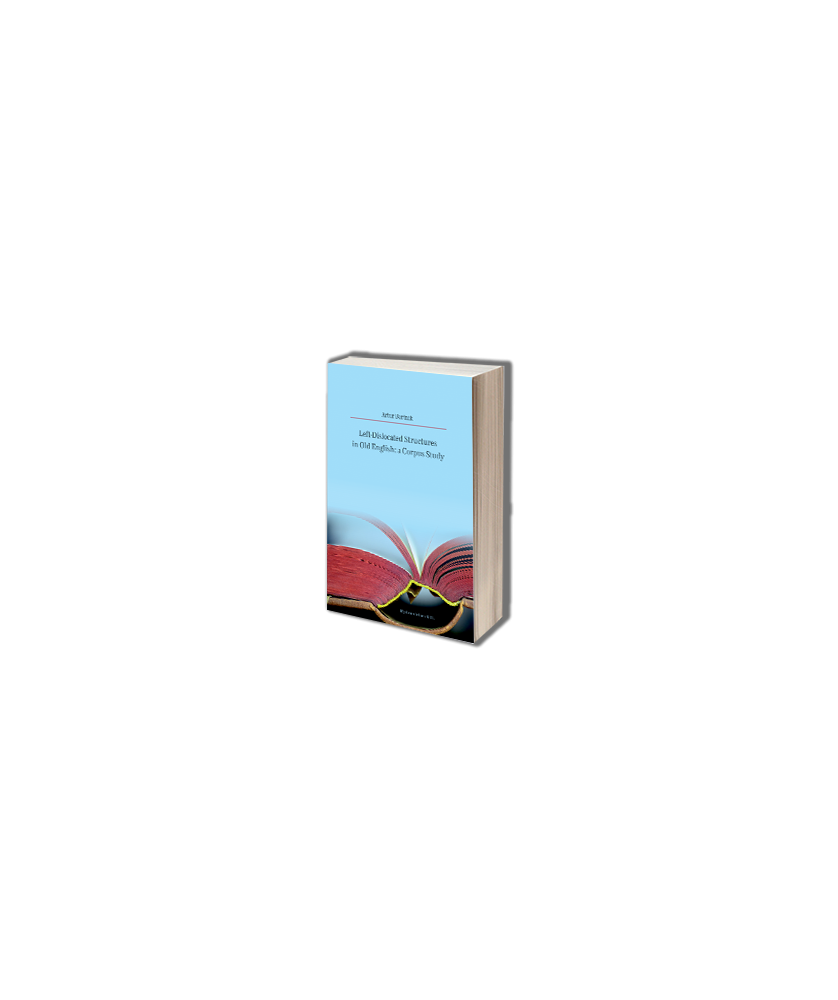
Left-Dislocated Structures in Old English: a Corpus Study
Artur Bartnik
ISBN: 978-83-8061-652-3
Stron: 260
Format: B5
Rok wydania: 2019
Abbreviations
Acknowledgements 
Chapter 1: Introduction 
1.1. Theoretical preliminaries 
1.2. Data and electronic corpora 
1.3. Dangers and pitfalls for a historical researcher 
1.4. A terminological note
1.5. Left-dislocation and correlation in traditional studies 
1.5.1. Synchrony
1.5.2. Diachrony 
1.6. Organisation of the book 
Chapter 2: Left-dislocation: a crosslinguistic view 
2.1. Introduction
2.2. A basic definition of left-dislocated structures  
2.3. Types of left-dislocation 
2.3.1. Tripartite division and terminology 
2.3.2. CLLD vs G(ermanic)LD  
2.3.2.1. Introduction 
2.3.2.2. Stacking 
2.3.2.3. The nature of LDed phrases 
2.3.2.4. Embedding 
2.3.2.5. Other tests
2.3.2.6. Summary
2.3.3. CLD vs HTLD
2.3.3.1. Introduction
58 2.3.3.2. The properties of CLD 
2.3.3.3. The properties of HTLD 
2.3.3.4. Summary 
2.4. Summary and conclusions 
Chapter 3: Left-dislocation in Old English 
3.1. Introduction 
3.2. A note on the literature 
3.3. HTLD and CLD structures in Old English: a quantitative study 
3.3.1. Introduction 
3.3.2. The type of resumptive
3.3.3. Case 
3.3.4. The position of resumptive 
3.3.5. Summary 
3.4. Critical evaluation of the CLD/HTLD criteria 
3.4.1. Introduction 
3.4.2. The type of resumptive, revisited 
3.4.3. Case, revisited
3.4.4. The position of resumptive, revisited 
3.4.5. Summary 
3.5. Other criteria: categorial possibilities, movement 
3.5.1. Categorial possibilities 
3.5.2. Movement 
3.6. Pragmatics 
3.6.1. Introduction 
3.6.2. Contrast and CLD 
3.6.3. Topic promotion and HTLD 
3.6.4. Summary 
3.7. Summary and conclusions 
Chapter 4: Correlative CLD and HTLD
4.1. Introduction 
4.2. Definition and properties of correlatives: a crosslinguistic perspective 
4.3. Correlative CLD and HTLD structures 
4.3.1. Introduction
4.3.2. Nominalisation 
4.3.3. Left-adjunction
4.3.4. The same introductory elements of the two clauses    
4.3.5. Demonstrative requirement
 4.3.6. Different realizations of heads, multiple relatives and more 
4.3.7. Summary   
4.4. More properties of correlative CLD and HTLD  
4.4.1. Complexity 
4.4.2. Quantification
4.4.3. Animacy 
4.5. The corpus data of correlative CLD 
4.6. The corpus data of correlative HTLD 
4.7. Summary and conclusions 
Chapter 5: Non-nominative correlatives 
5.1. Introduction 
5.2. Corpus data 
5.3. Previous analyses of non-nominative structures 
5.3.1. Introduction
5.3.2. Internal heads and non-nominative structures
5.3.3. An alternative account: external heads and inverse attraction 
5.3.4. Long-distance case assignment
5.3.5. Summary 
5.4. Analysis: the evolutionary approach (Kiparsky 1995, Bianchi 1999, 2000)
5.4.1. Introduction 
5.4.2. Kiparsky (1995), Bianchi (1999, 2000)
5.4.3. Defective C 
5.4.4. Default case 
5.4.5. Hock (1988, 1991) 
5.5. Parataxis and hypotaxis cline 
5.5.1. Parataxis and hypotaxis in traditional headed relatives 
5.5.2. Parataxis and hypotaxis in correlatives  
5.6. Summary and conclusions 
Chapter 6: Final Conclusions 
References


